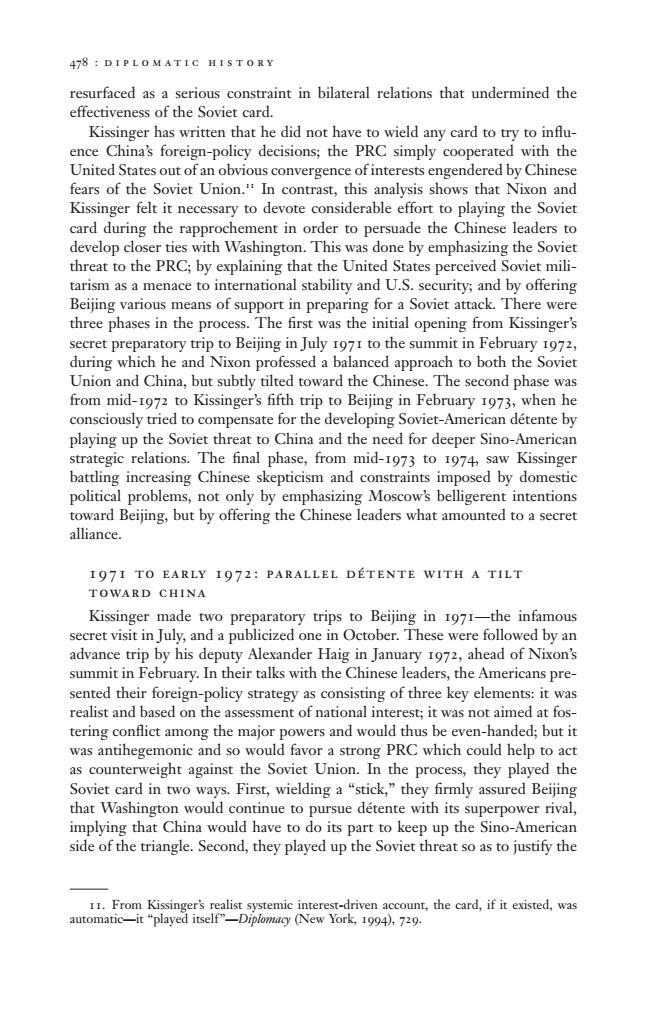正在加载图片...

478:DIPLOMATIC HISTORY resurfaced as a serious constraint in bilateral relations that undermined the effectiveness of the Soviet card. Kissinger has written that he did not have to wield any card to try to influ- ence China's foreign-policy decisions;the PRC simply cooperated with the United States out of an obvious convergence of interests engendered by Chinese fears of the Soviet Union."In contrast,this analysis shows that Nixon and Kissinger felt it necessary to devote considerable effort to playing the Soviet card during the rapprochement in order to persuade the Chinese leaders to develop closer ties with Washington.This was done by emphasizing the Soviet threat to the PRC;by explaining that the United States perceived Soviet mili- tarism as a menace to international stability and U.S.security;and by offering Beijing various means of support in preparing for a Soviet attack.There were three phases in the process.The first was the initial opening from Kissinger's secret preparatory trip to Beijing in July 197I to the summit in February 1972, during which he and Nixon professed a balanced approach to both the Soviet Union and China,but subtly tilted toward the Chinese.The second phase was from mid-1972 to Kissinger's fifth trip to Beijing in February 1973,when he consciously tried to compensate for the developing Soviet-American detente by playing up the Soviet threat to China and the need for deeper Sino-American strategic relations.The final phase,from mid-1973 to 1974 saw Kissinger battling increasing Chinese skepticism and constraints imposed by domestic political problems,not only by emphasizing Moscow's belligerent intentions toward Beijing,but by offering the Chinese leaders what amounted to a secret alliance. 197I TO EARLY 1972:PARALLEL DETENTE WITH A TILT TOWARD CHINA Kissinger made two preparatory trips to Beijing in 1971-the infamous secret visit in July,and a publicized one in October.These were followed by an advance trip by his deputy Alexander Haig in January 1972,ahead of Nixon's summit in February.In their talks with the Chinese leaders,the Americans pre- sented their foreign-policy strategy as consisting of three key elements:it was realist and based on the assessment of national interest;it was not aimed at fos- tering conflict among the major powers and would thus be even-handed;but it was antihegemonic and so would favor a strong PRC which could help to act as counterweight against the Soviet Union.In the process,they played the Soviet card in two ways.First,wielding a "stick,"they firmly assured Beijing that Washington would continue to pursue detente with its superpower rival, implying that China would have to do its part to keep up the Sino-American side of the triangle.Second,they played up the Soviet threat so as to justify the II.From Kissinger's realist systemic interest-driven account,the card,if it existed,was automatic-it "played itself"-Diplomacy (New York,1994),729.resurfaced as a serious constraint in bilateral relations that undermined the effectiveness of the Soviet card. Kissinger has written that he did not have to wield any card to try to influence China’s foreign-policy decisions; the PRC simply cooperated with the United States out of an obvious convergence of interests engendered by Chinese fears of the Soviet Union.11 In contrast, this analysis shows that Nixon and Kissinger felt it necessary to devote considerable effort to playing the Soviet card during the rapprochement in order to persuade the Chinese leaders to develop closer ties with Washington. This was done by emphasizing the Soviet threat to the PRC; by explaining that the United States perceived Soviet militarism as a menace to international stability and U.S. security; and by offering Beijing various means of support in preparing for a Soviet attack. There were three phases in the process. The first was the initial opening from Kissinger’s secret preparatory trip to Beijing in July 1971 to the summit in February 1972, during which he and Nixon professed a balanced approach to both the Soviet Union and China, but subtly tilted toward the Chinese. The second phase was from mid-1972 to Kissinger’s fifth trip to Beijing in February 1973, when he consciously tried to compensate for the developing Soviet-American détente by playing up the Soviet threat to China and the need for deeper Sino-American strategic relations. The final phase, from mid-1973 to 1974, saw Kissinger battling increasing Chinese skepticism and constraints imposed by domestic political problems, not only by emphasizing Moscow’s belligerent intentions toward Beijing, but by offering the Chinese leaders what amounted to a secret alliance. 1971 to early 1972: parallel détente with a tilt toward china Kissinger made two preparatory trips to Beijing in 1971—the infamous secret visit in July, and a publicized one in October. These were followed by an advance trip by his deputy Alexander Haig in January 1972, ahead of Nixon’s summit in February. In their talks with the Chinese leaders, the Americans presented their foreign-policy strategy as consisting of three key elements: it was realist and based on the assessment of national interest; it was not aimed at fostering conflict among the major powers and would thus be even-handed; but it was antihegemonic and so would favor a strong PRC which could help to act as counterweight against the Soviet Union. In the process, they played the Soviet card in two ways. First, wielding a “stick,” they firmly assured Beijing that Washington would continue to pursue détente with its superpower rival, implying that China would have to do its part to keep up the Sino-American side of the triangle. Second, they played up the Soviet threat so as to justify the 478 : diplomatic history 11. From Kissinger’s realist systemic interest-driven account, the card, if it existed, was automatic—it “played itself”—Diplomacy (New York, 1994), 729